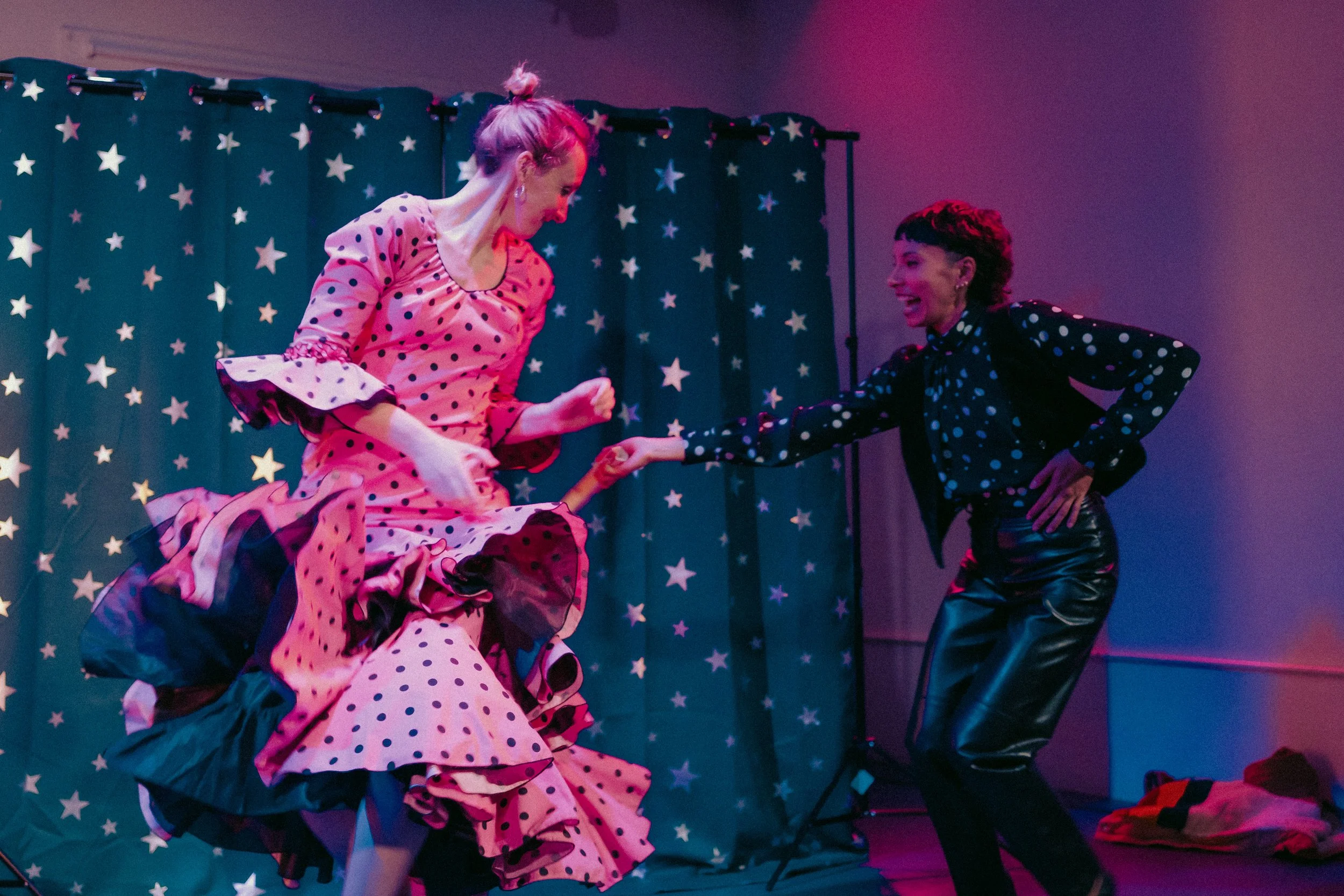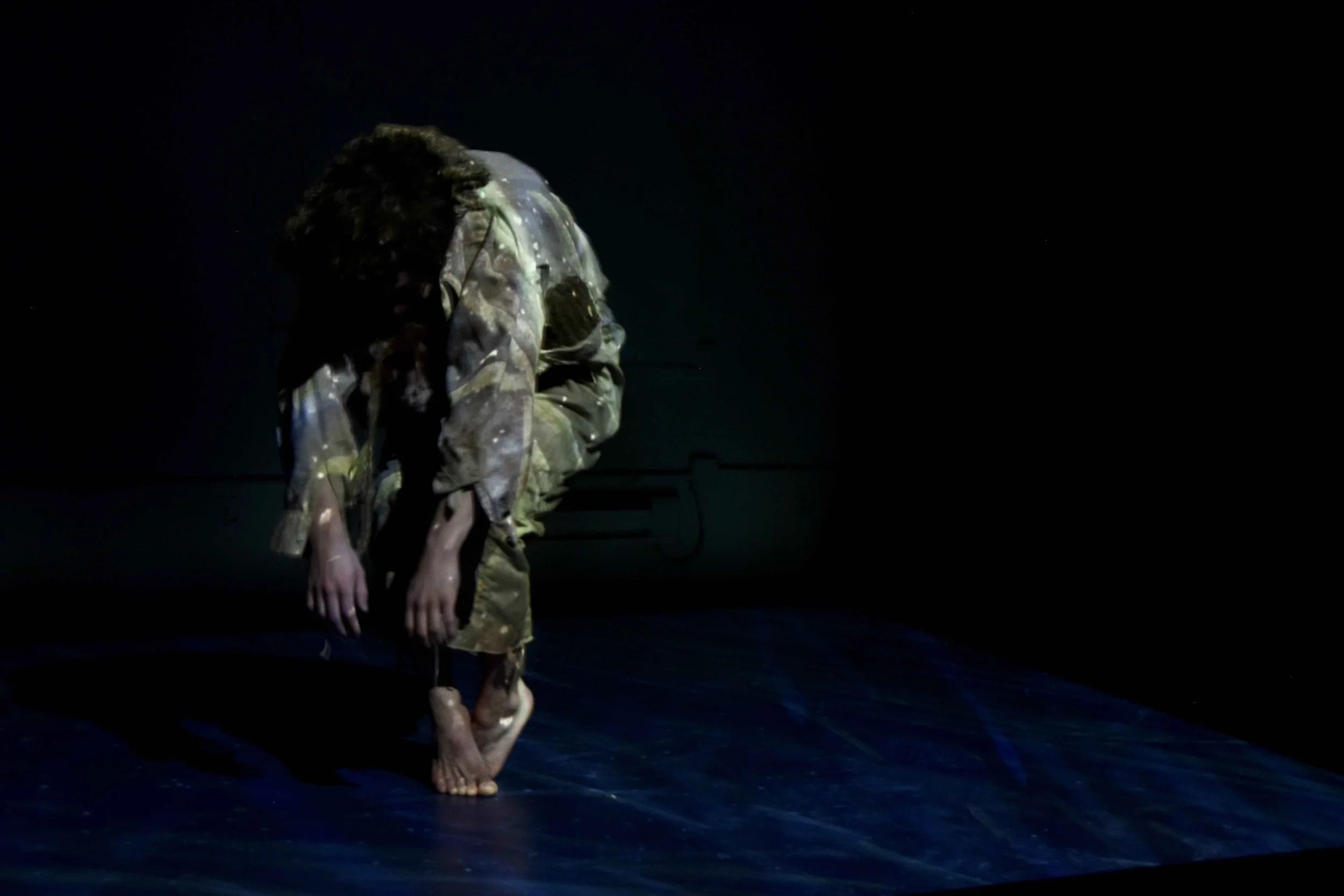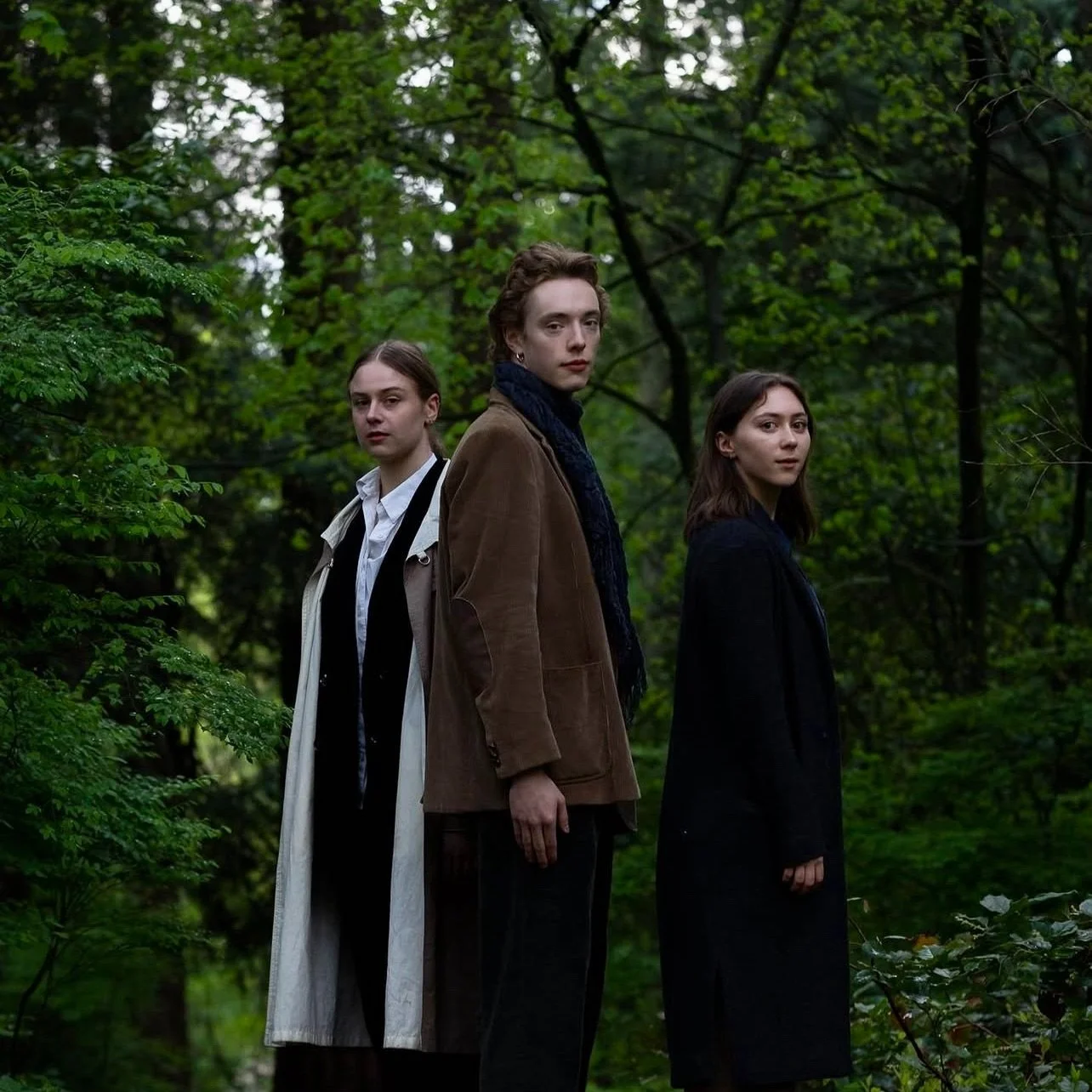In Kin, AJ Simmons and Kelty McKerracher navigate queering the art of flamenco
Performance at Downtown Eastside Heart of the City Festival sees artists break away from traditional gendered movements and costumes
Kelty McKerracher (left) and AJ Simmons in Kin. Photo by Pedro Augusto Meza, Dayna Szyndrowski, and Íker Castro
Downtown Eastside Heart of the City Festival presents Kin at KW Production Studio on November 9 at 8 pm
HISTORICALLY, FLAMENCO DANCERS have adhered to very particular gender roles. Born in the streets of 18th-century Andalusia within oppressed Romani and Moorish communities, the culturally rich artform became a backbone of creative expression in southern Spain that is now designated among UNESCO’s Masterpieces of the Oral and Intangible Heritage of Humanity. Oft-seen visuals include women moving sinuously in ruffle-trimmed traje de flamenca dresses and sharp-dressed men performing powerful footwork.
But in this day and age, dancers are beginning to reject those ideas of traditional gender roles. Take, for instance, Compañía Rocío Molina’s explosive Caída del Cielo at last year’s Vancouver International Flamenco Festival, where audiences watched the sensational Molina splatter a plastic bata de cola skirt in fake blood and stamp thunderously onstage barefoot; or most recently, La Sporée’s robotics-infused Èbe at the Vancouver International Dance Festival, in which Sarah Bronsard sported a nontraditional tie-dye bodysuit and jeans while maneuvering remote-controlled accordions.
At this year’s Downtown Eastside Heart of the City Festival, artists AJ Simmons and Kelty McKerracher are putting their own twist on the art form with a work-in-progress performance of Kin, a piece that explores the concept of queering flamenco. Over a joint Zoom call with McKerracher, Simmons tells Stir that the desire to push the boundaries of flamenco came early on in their immersion of the style, particularly through witnessing performances by the likes of Al Mozaico Flamenco and Karen Flamenco in the Chai Lounge at the vibrant Main Street restaurant East is East while working as a server there.
“When I was watching flamenco, I was just really moved and drawn in,” Simmons recalls. “But as I started dancing and I listened to and observed the kind of inherent gender norms that were being portrayed—both in class when I was studying, and on stage when I was watching at East is East—the language that was used traditionally was, ‘Women dance like this. You want to move your hips like this.’ And there were male dancers in the class that were invited to dance in a different way. So I was really noticing these kinds of unconscious dynamics playing out.
“I think everyone in the flamenco community will really attest to the fact that everyone can dance the way they want to,” she adds, “and there’s a real welcomeness and an invitation to show up as you are. I think that’s why so many people are called to flamenco, is that they get to express these parts of themselves.”
Kelty McKerracher (left) and AJ Simmons at Queer Flamenco Project 2023. Photo by Jarell Alvarez
Simmons, who has a background in Irish dance, began her flamenco training with Karen Flamenco. After embarking on a trip to Grenada, Spain, she returned to study privately with Oscar Nieto and Kasandra “La China” Lea of Al Mozaico Flamenco. During that time, separate discussions with Sammy Chien of the Chimerik Collective prompted her to consider how the simple act of being a queer person performing flamenco was in and of itself a way of queering the art form.
With that in mind, Simmons set out to develop the foundation of Kin earlier this year during a residency in Mexico with experimental flamenco artist Ricardo Rubio. Together, they researched creative expression in the art form through a combination of ritual practices; the physical elements (earth, air, water, and fire); and los cinco ritmos sagrados, or the five sacred rhythms (Rubio’s unique interpretation of Gabrielle Roth’s “5Rhythms” movement states—flowing, staccato, chaos, lyrical, and stillness).
Another key component of Simmons’s learnings with Rubio was the use of the loop pedal, a musical tool with which she was already familiar from exposure to Scottish ballad interpretations by her partner, Vancouver-based multidisciplinary artist Claire Love Wilson (who is also a friend of McKerracher’s—and how the two dancers first met). Rubio helped Simmons create a choreographic structure using those concepts, which she then performed in Mexico.
When Simmons returned home, she and McKerracher morphed that initial bundle of methodology—looping, rituals, elements, and rhythms—into Kin. The result is a wildly experimental take on flamenco. The piece also reckons with each performer’s relationship to the Spanish and English languages as they alternate between cante (singing) and baile (dancing).
“People often think of women in these big frilly dresses with big polka dots,” Simmons says. “They think of men in tunic shirts with really high-waisted tight pants, dancing ferociously. And I just was really kind of disinterested in that. It was really exciting to get to work with Oscar, to feel that I could move between this kind of spectrum of movement that isn’t a part of flamenco, and also play with the real presentational, gendered aspects of flamenco: What is it to wear pants, but also to move my hips in a way that is maybe not necessarily connected to the traditional way of dancing in pants? So I think that that period with him really rooted me in my exploration.”
Throughout their ongoing research into gendered movement, adds McKerracher, the artists have found inspiration from strong figures like the late Carmen Amaya, a famed Romani flamenco artist who is widely regarded as the first woman to master the explosive footwork that was previously only performed by men.
McKerracher began her flamenco training at Al Mozaico, where—like Simmons—she studied with mavens Nieto and Lea and completed six months of foundational training in Grenada, Spain. During those formative years, she performed at local flamenco hotspots like the Kino Cafe (which closed during the pandemic) and the Chai Lounge at East is East.
Kin isn’t McKerracher’s first time bringing flamenco to the Downtown Eastside. From 2010 to 2017, the artist taught classes in the community and hosted an annual show at the Downtown Eastside Heart of the City Festival called Barrio Flamenco (barrio, she notes, fittingly means “neighbourhood” in Spanish).
“Flamenco in the Downtown Eastside has been a presence before, and something that I stewarded,” McKerracher says. “And you know, I always did carry that question, ‘What is my role here as being an ambassador of this art form that comes from a completely different land, and that I share no ancestral relationship with?’ It’s an adopted art form. It’s something that I’ve fallen in love with, and I’m bringing it here and introducing it in a community-engaged way, a way that’s more accessible. And it’s about celebrating the heart of the art form, which is truly about community.”
Similarly to how flamenco originated within the oppressed communities of southern Spain, notes McKerracher, it has now become a powerful tool of expression for marginalized communities within the Downtown Eastside. Connecting with those folks while honouring history allows McKerracher and Simmons to truly experiment with the art form.
“We’re trying to earn our relationship with flamenco,” McKerracher says. “We’re trying to earn flamenco by doing the work of self-inquiry in our own lineages, our own positionality, how we relate to the land that we’re on, how we relate to our ancestors, and what we’re actually bringing to the art form—rather than just trying to imitate this thing that comes from somewhere else, which is a very settler-colonial way of relating to something. To discover for ourselves what our relationship is with it, that’s very queer.
“You know, ‘queer’ is so much more than sexual orientation,” she continues. “It’s a way of being and a way of questioning and disrupting what’s considered normative. So I think that’s what we’re trying to bring forward with this show in a way that is very tender between the two of us in our relationship as it’s evolving.” ![]()

























